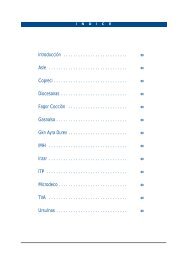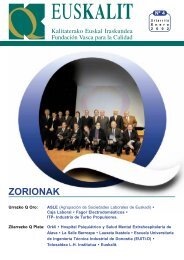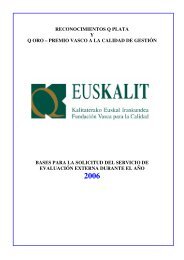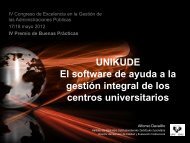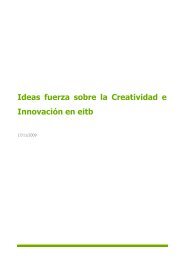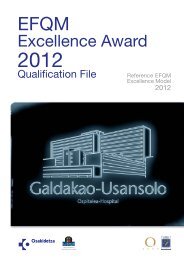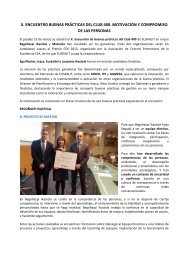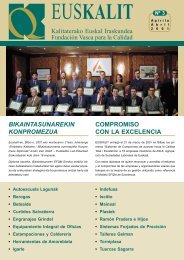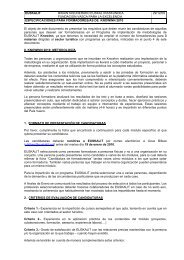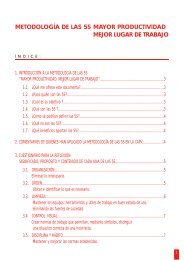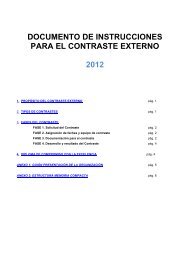Olabide Ikastola - Euskalit
Olabide Ikastola - Euskalit
Olabide Ikastola - Euskalit
Create successful ePaper yourself
Turn your PDF publications into a flip-book with our unique Google optimized e-Paper software.
partnerships<br />
& resources<br />
4 PARTNERSHIPS & RESOURCES EFQM Excellence Award 2010 36<br />
YEAR<br />
2006-<br />
07<br />
2008-<br />
09<br />
REVIEW AND<br />
LEARNING<br />
Reflection by<br />
MT<br />
Review of<br />
procedure<br />
Reflection by<br />
MT<br />
Request made to<br />
City Council<br />
Reflection by<br />
MT<br />
IMPROVEMENT ACTION<br />
Part of former canteen adapted for<br />
use as a classroom for the Science<br />
project in PE, and construction of a<br />
common room for leisure purposes<br />
for CSE and USE pupils.<br />
Coding system introduced to<br />
facilitate inventory<br />
Refurbishing of the oldest of the<br />
<strong>Olabide</strong> buildings, with creation of a<br />
covered storage area for maintenance<br />
material and a bicycle park.<br />
Provision (by the City Council)<br />
of a cycle path to the school, thus<br />
improving access and safety<br />
Implementation of a system for<br />
the automated management of the<br />
heating and hot water system<br />
4d. Technology is managed to support the delivery of strategy<br />
Approach and deployment<br />
In <strong>Olabide</strong>, we believe it essential to fully understand and harness<br />
the benefits of a series of educational principles if we are to offer a<br />
quality education to our pupils. These principles, in line with our<br />
MVV and embodied in the content of our 3 strategy plans since<br />
1998 (e.g. in the SP 2004-08; StP 1.8, 2.4, 3.1 and 3.2, 2c, and SP<br />
2009-12; Strategic Objective on ICTs, Qualification File), necessarily<br />
involve the widespread selection, deployment and use of<br />
technology in different areas, as outlined below.<br />
Education-related technology, including:<br />
• the methodology for designing teaching programmes, specifying<br />
what needs to be taught for our pupils to obtain the required<br />
competencies (model of Teaching Unit), and coordinating and<br />
aligning the different activities performed by teachers in the<br />
course of their teaching duties;<br />
• innovation programmes, e.g. CREA (creativity), IDEAL (for<br />
stable behaviour in problematic situations), Ulises (emotional<br />
self-control), Bizikidetza (co-existence), Science, Bizi Zaitez<br />
(cycling as means of transport), etc., designed to strengthen<br />
certain pupil competencies considered by us to be essential for<br />
their success in the future; and<br />
• linguistic planning, designed to deliver objectives related to the<br />
language competence of our pupils, as stated in our strategic<br />
documents (SEP, SP, Language Project, etc.).<br />
Information and Communication Technologies (ICTs), including<br />
all methodologies and technical elements related to the management<br />
of information. To this end, a specific ICT Area, made up<br />
of both teaching and non-teaching staff, was set up in 2003-04<br />
to select, deploy and monitor the effectiveness and efficiency of<br />
all matters related to this area of management. Nowadays, the<br />
ICT Area of the school includes technicians who dedicate their<br />
time almost exclusively to this Area. Additionally, the ICT Area<br />
is under the direct supervision of the Head of Teaching to ensure<br />
that the approach followed in this area responds to the basic<br />
needs of the school. In 2008-09, the subject of computer science<br />
was taken out of the curriculum in favour of a more all-round,<br />
wider use of new technology in all curricular subjects. This decision<br />
has led to a considerable increase in the number of teaching<br />
hours involving the use of ICTs and their deployment in the vast<br />
majority of subjects.<br />
Other technologies, including all those technologies which enable<br />
a more efficient use of our material resources and people,<br />
e.g. the use of solar panels and low consumption light bulbs, or<br />
the centralised and automated security system, which has led to<br />
improvements in terms of restricted access and greater efficiency<br />
in the area of human resources.<br />
Technology management in <strong>Olabide</strong> is designed to meet the following<br />
needs:<br />
• to identify the technology needs of our people and customers;<br />
• to identify and evaluate emerging technologies;<br />
• appropriate use of external resources in relation to technology<br />
management; and<br />
• the use of technology to support improvement.<br />
The flowchart for technology management in <strong>Olabide</strong> is as shown<br />
below.<br />
Laws<br />
Surveys/<br />
requests<br />
DETECTION<br />
OF NEEDS<br />
Identification of<br />
technologies<br />
SELECTION<br />
Integration/ evaluation<br />
Market<br />
Forums<br />
no<br />
Valid?<br />
Integration into EMS<br />
New teaching methodology is most commonly incorporated<br />
through an innovation project (Project Management Process,<br />
3c & 5a). All innovation projects are assigned a project leader<br />
and team, and specific project objectives are established. Additionally,<br />
project planning includes a time chart for project training,<br />
development and implementation and specification of the<br />
resources required. In the course of the implementation stage,<br />
the project leader reports to the MT on the progress made, and<br />
on its conclusion, the project leader is responsible for assessing<br />
whether the established objectives have been met and planning<br />
how best to transfer the acquired knowledge into the EMS.<br />
In any case, all projects are managed in line with the principles laid<br />
out in <strong>Olabide</strong> basic documents (the SEP and the SCP), and with<br />
the stated objectives of the PS for Strategy and the Process for the<br />
Review and Adaptation of the School Curriculum Project.<br />
The guiding principles, innovation programmes/ projects developed<br />
and technologies applied in them in recent years are shown<br />
in the table below.




